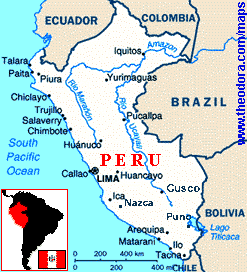 Machu Picchu Machu Picchu
-- Story by Erin --
Machu Picchu in the Quechua language means "Old
Mountain". The Inca kings decided to build a hidden city here at the top of this
mountain and in a discreet valley as an educational center for the children of the nobles
of other tribes, which they conquered. There is lush greet forest which covers the
mountains, the temperature is warm and humid, and clouds drift through the valley during
the day, often blanketing the ruins temporarily in white. From the Urubamba River below it
is impossible to see the city. Even the Spanish invaders of the 1500s, exploring the river
valley below, never found it (and therefore it was not destroyed). Machu Picchu lay hidden
under dense jungle growth for hundreds of years after the Spanish finally defeated the
last Inca king. Because Machu Picchu was a secret to all but the king and his loyal
subjects, this secret place died with him. In 1911, an American researcher named Hiram
Bingham accidentally stumbled upon the place when he was looking for the fabled city of
gold. After that, an archaeological team from Yale arrived to excavate the place. What
exists now to see are elaborate staircases built into the existing rocks, canals and
baths, vast agricultural terraces, temples, palace rooms, sun dials and rock formations
representative of condors, mirror images of mountains, etc. The stone masons that
constructed the place were highly sophisticated, creating huge perfectly geometric stone
blocks that could be placed one on top of the other without mortar to keep them together.
To this day, most of the foundations are in perfect condition, despite periodic
earthquakes.
Tuesday, July 2nd: Our Machu Picchu trek! At 6am we were on the bus to the
train station with the other 9 members of our group, plus our guide Ruben and assistant
guide Juan. We were all sleepy but managed to make introductions: Gabriela, Jackie, Rob
and Jesse from Los Angeles (Gabriela, Jackie and Jesse are siblings), Chris and Jenny from
Chicago, Carin and Vincent from Holland, and Patrick (originally from France) from New
Jersey. We bought some cakes from one of the many vendors attacking tourists as they got
out of vans, and quickly boarded the train just before its 6:30am departure. The train
began its 4 hour journey by first zigzagging back and fourth up the side of the mountain
and away from Cusco – the train goes forward for several hundred meters, stops,
reverses direction, catches a spur upwards for a few more hundred meters, stops, reverses
direction… After about 30 minutes of this dance, the train reached the top of the
mountain and continued in a normal fashion. The rest of the way the tracks followed the
Urubamba River through lush green valleys to where we finally exited at km. 104 at
10:30am. (Yes, it took 4 hours to travel 104kms!). Although there is no station here and
nothing more than a marker alongside the tracks, there were women selling all manner of
things from Snickers candy bars to plastic rain ponchos. We buy 2 ponchos because it
looked like it might rain as we had left our rain gear behind (wishful thinking!)
After the first checkpoint (and bathroom stop) we started our trek---at the end of the
day we had climbed 700 meters in altitude. The trail was good but very narrow. We had to
constantly pay attention to where we were walking, as it was a steep drop down. The
beginning of the walk was a fairly gentle uphill grade, which gave us a good opportunity
to chat with our other group members and get to know each other. Luckily, the
area/altitude around Machu Picchu is much lower than Cusco and we didn’t need oxygen
masks to assist us! It was a welcome break to be at lower altitude, finding breathing much
easier and the climate warm and slightly humid. The views of the valley below, the winding
river, and the mist-covered mountains were spectacular. In a way we were lucky not to have
sunny weather because it would have been very hot and humid otherwise.
Near the highest point of our climb that day we reached the ruins of Winay-Wayna,
another significant site not only for its architecture but also its agricultural terraces.
Its perched up very high on the side of a mountain and faces directly east so that the
terraces always get the maximum amount of light. Winay-Wayna helped supply food to the
workers who built Machu Picchu. This is where we started to feel our legs turn to jelly.
We had to ascend steep sets of stone stairs, and we felt our lungs burn as well.
After a nice break at the top to enjoy the views, we pushed on a bit further up hill!
Finally we reached the climax of the day, Intipunku, the Sun Gate. The sun first shines
through this gate as it rises on the morning of the winter solstice each year. Here we had
our first peak at the huge Inca site of Machu Picchu, settled on top of a mountain below
us. However our time to enjoy this spot was short-lived as it started to rain in earnest,
just when we wanted to enjoy our downhill descent! We all finally donned our lovely
ponchos and carefully walked down the stony steps, slipping and sliding occasionally,
until we reached the entrance to the site of Machu Picchu. We quickly met the last bus of
the day (5:30pm) down to the town of Aguas Calientes (a common name for towns with thermal
baths in South America) where we would spend the night.
We stayed in a nice little hostal and each got our own rooms. (The other tour groups
stop at a hostal near Winay-Wayna where they get to sleep in a dorm room with 60 beds!!!)
After getting settled in and having tea, we jumped into our bathing suits and headed for
the thermal baths the town is famous for. The baths are situated at the top end of town,
where you have to cross a wooden walking bridge over a raging river to get to the baths.
When we finally reached it (having walked up several flights of stone steps----again!) we
found several different pools, all different temperatures. It soothed our aching muscles
and was a nice way to wind down from the day. Later we returned back to the hostal for
dinner and then quickly off to bed---well for some of us anyway. Our assistant guide Juan
was an expert on the local nightlife and guided Chris along with the LA and Chicago
contingents out to the local pub for some drinks and billiards.
We were woken the next morning at 5:30am, breakfast at 5:45am and on the bus at 6:20am
back up to Machu Picchu. It was no use hoping to see the sunrise as it was still somewhat
cloudy. But, getting there early is a bonus because few people are there at that time.
Ruben led us around the ruins to the significant places: the temple of the sun, the
scientific rooms, the baths, the experimental terraces, etc. and explained their purposes.
It is truly amazing how advanced this civilization was and how well organized. Ruben
explained that Machu Picchu was not really a city, but an educational center for the
children of the nobles. Only about 1,500 people occupied this vast site.
The weather had cleared nicely and around noon we took a break for a snack and some
drinks. And then, just when we thought we’d done enough walking uphill, Ruben took us
up Huayna Picchu (meaning "young mountain"), the big mountain behind MP, which
has ruins at the top and great views. This place was supposed to be the storehouse for the
excess foodstuffs for times of drought, bad harvests, or when the Inca would give food to
other tribes in order to control them. It was about 35 minutes climbing straight uphill on
stone steps. Probably for all of us, it was the hardest bit we had to do in the whole 2
days. We were rewarded however when we finally reached the top. The views were indeed
spectacular and you felt like you were on top of the world! After about a half-hour
wandering around the top and snapping off tons of photos we started down again. It started
to drizzle, just as we descended the hardest part of the steps, crab walking down the very
narrow/steep stones. About halfway down I finally slipped and fell on the slippery rocks.
Luckily there are ropes and cables along the way and I was able to hold on rather than
tumble down the mountain.
Fortunately the rest of the way down was uneventful and we quickly made our way back to
the buses to take us down the mountain. Some of the more energetic of our group-----Chris,
Rob, Carin, Juan---- ran down the steps back to Aguas Calientes. There we had our final
meal together for lunch and caught the train to Cusco at 4:30pm. Our tired but proud group
arrived in Cusco at 8:30pm and we all agreed to meet the next night for happy hour before
saying our last good-byes.
We highly recommend SAS
Tours -- the price was a whopping $130/pp, but everything in/around Cusco is expensive
(and quoted in DOLLARS). Other companies offer the tour for a couple of dollars
less, but we were very impressed with SAS's professionalism and wanted English speaking
guides. The 4-day Inca hike with SAS is US$240/pp. We heard some people got
4-day tours for US$150-190/pp, but they are generally pooled into much larger groups,
guides are not as well informed, tents may leak, and basically you don't end up with the
company you signed on with.
Another option is to do a tour on your own -- You can only
walk on the Inca Trail with a company/guide, but you can take the train to Aguas
Calientes and do day-trips into MP on your own: $40 for the Round-trip train,
$20/day to enter MP, $4.50 for bus up (you can walk back down in 45 minutes), and $5-30/pp
for hostal (plenty to choose from). You don't need a guide to enter Machu Picchu
itself, but you can hire a private guide there for about $10-30/pp (depending on your
negotiating skills/number of people). We would definitely recommend spending at
least one night in Aguas Calientes (you can add onto any of above tours).
Motorcyclists can ride to Ollantaytambo, park the bike for $0.30/day, and take a train to
Aguas Calientes for $20/RT. You can not ride to Aguas Calientes -- there is no
road/trail.
THE GANG:
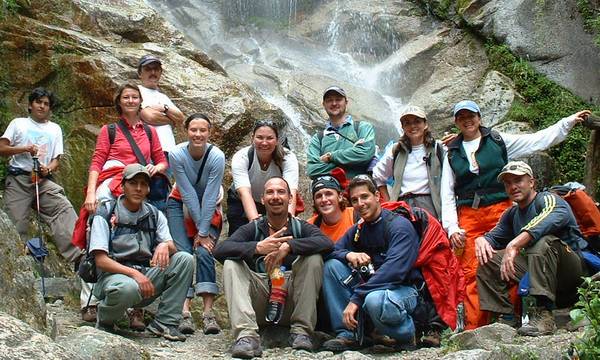
Ruben, Carin, Patrick, Jenny, Erin, Vince, Gabriela, Jackie
Juan, Chris, Chris, Rob, and Jesse
|
Winay-Wayna
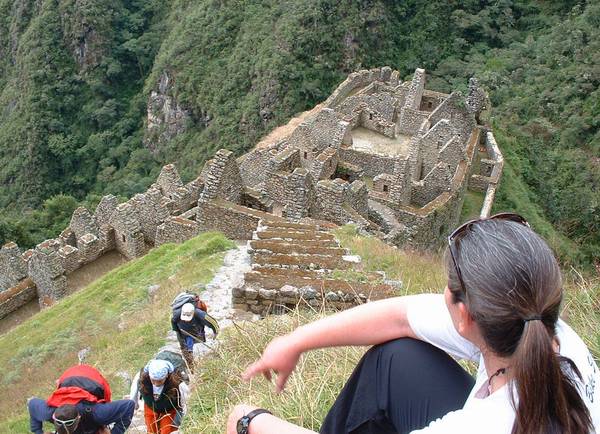
|
Machu Picchu
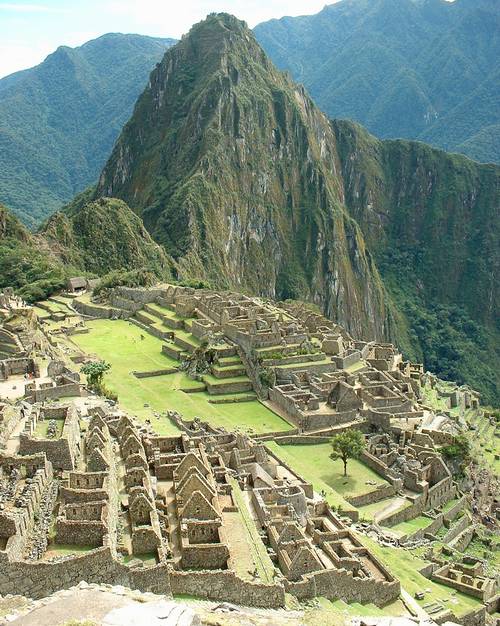
|
Blue Skies over Machu Picchu -- Huanya Picchu is at the top of the mountain to the right
(yes, we climbed it!)
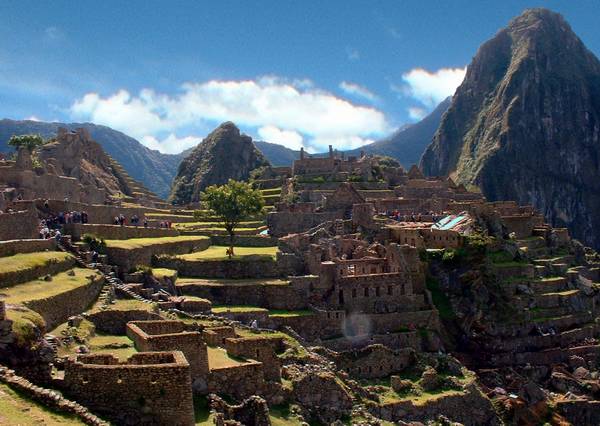
|
Terraces in the mist
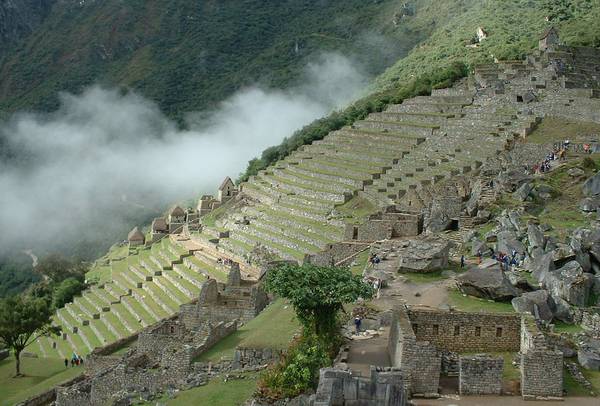
|
The walls of the temples and noble houses were made of rocks cut into exact shapes,
filling all gaps, and without the use of mortar. The more important the structure,
the bigger/better the rocks. The rock wall at the bottom right of the photo, along
with the other homes were made of normal stone and mud for mortar
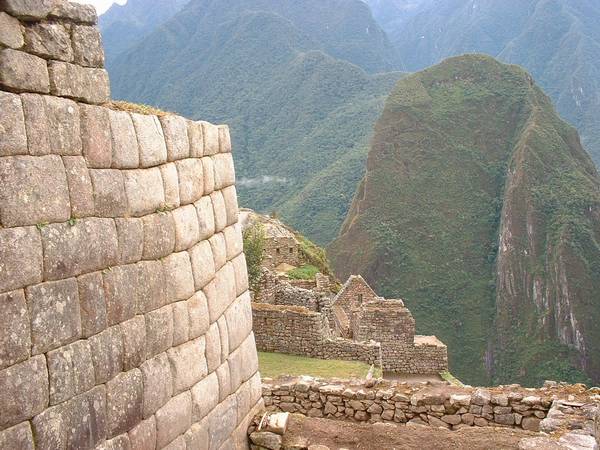
|
Stonework: The Incas utilized existing boulders which they carved and
incorporated rocks cut into intricate shapes to fill and for support.
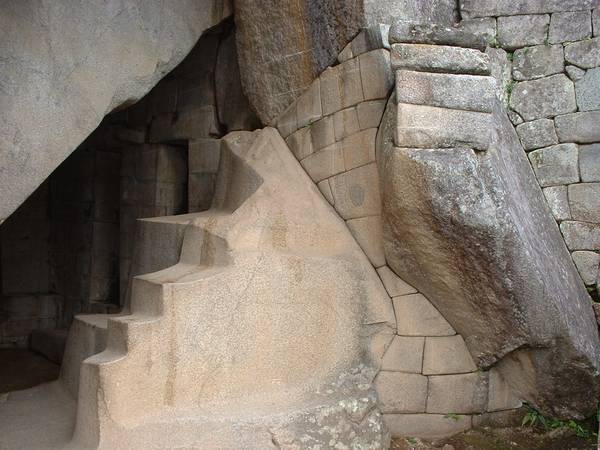
|
|